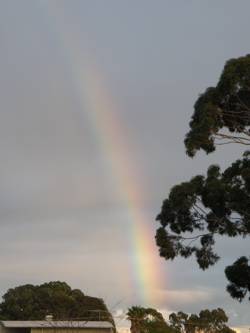Family History Through the Alphabet Challenge: R is for … Reference Books and Rainbows
Behind every researcher there is a great big, huge, pile of reference books that they constantly use to help them along the way. This pile of reference books can start right from the beginning when you are an amateur researcher, and continues right through to the professionals. And just to be clear, I’m not confining this habit of collecting reference books just to family history researchers … but shall go as far as saying that it encompasses ALL researchers, in ALL fields. So for R my post in the Family History Through the Alphabet challenge
R is for REFERENCE BOOKS
Now to bring this topic back to genealogy … well, I for one know that I would be lost without my reference books. These aren’t books that you read from cover to cover, but they are there waiting to be grabbed off the shelf every so often to answer that question that has just arisen. What parish is that place in? Were they in Australia that early? What on earth is that occupation? Was that place under German rule at that time? Who were the kings of Scotland? Where is that place? How did that town get its name? You know the norm for a genealogist …
Anyway I do find reference books (and CDs for that matter) invaluable, but rather than ramble on about how useful they are, as I’m pretty sure I’d be preaching to the converted, I’ve decided to list my top 6 reference books (yep, for this post, I’m excluding the reference CDs, and it’d be just WAAAY too hard to choose), so books only it is.
These are the ones that I grab off my shelf the most (in alphabetical order):
1. Australian Biographical and Genealogical Record
Who doesn’t love biographies eh? The ABGR Series is chock full of Australian biographies (and includes many photos for that matter too), so it always worth a look when researching someone in Australia.
2 . Bartholomew’s Gazetteer of Britain
I’d be lost without my Bartholomew’s Gazetteer. Covering England, Ireland, Scotland and Wales, it helps me locate where places are (or were), together with giving me an idea about the place (how big it was) and so on.
3. Manning’s Place Names of South Australia (later edition known as Place Names of our Land)
Anyone who has done much research in South Australia is likely to have come across Manning’s Place Names. Geoffrey Manning’s book is known as the ‘bible’ for places in South Australia, not only listing places, together with Gazetteer type info, but also giving the origin of the place name itself.
4. Musters of New South Wales
Useful for finding convicts or early emigrants in early New South Wales. They contain many 1000s of entries for convicts and free people, including children – age, ship of arrival, sentence, occupation, employer, place of residence.
5. Notorious Strumpets and Dangerous Girls
This huge book is listing women who were sent to Van Diemen’s Land as convicts between 1803-1829. But is much more than just a listing, as the author has researched these women and added in all details found relating to each. Name, Police Number, Convicted At, Convicted Date and Sentence, Transported for, Gaol Report, Stated Offence, Ship’s Surgeon’s Comments, Description, Colonial Experiences. And thanks to Mr Lonetester’s plethora of convicts, this book has proved very useful. 😉
6. Pioneer Register of Australia
This is one of my all-time fav sets of books. Compiled by C.J. Smee, this series comes as six volumes which I did eventually track down. Listing early emigrants to Australia together with their children and grandchildren, this is an amazing compilation. However one disappointing thing is that Mr Smee didn’t include reference of where he obtained information, so I use his info as a guide only, rather than fact.
—————————————–
R is for RAINBOWS
Now I bet I have you a little puzzled about this one don’t I?
You know people say researching the past is great, but don’t forget to write down your own history and stories … well this is a mini one of mine. Acutally it’s more of an anecdote really, but still – it’s to do with me, not my ancestors (well, not that I know of).
I LOOOOOOOOVE rainbows. Always have, and I expect that I always will. I was looking through my old highschool art books recently, and many of them (surprise, surprise) either featured a rainbow, or were coloured in rainbow colours.
The one thing Mr Lonetester reminds me of, is the day I was waiting at the lights, saw a rainbow and then got tooted by all the cars behind as I hadn’t noticed that the lights had changed. I was too busy gazing at the rainbow. 😉
So dear readers and geneabloggers, there’s a little reminder to write about yourself from time to time, so your descendants will know more about you. Your likes and dislikes. Your personality. Your life.






Great references, Alona. I’m also a fan of #5. I agree with us having to record things now for our descendants, especially in this age of technology. We also need to handwrite because books will never need a special app to open them 😉
Absolutely Fi. It is sad that the art of handwriting is being lost to technology. And we know that feeling of how special it is to find something written in our ancestors own handwriting. We need to keep that in mind for our future genealogist descendants.
Yep you had me puzzled with Rainbows…but aren’t they magical 🙂 Thanks for sharing that story with us and reminding us to tell our own tales….in writing as Fiona says. I agree that whatever else happens (in theory!) a book should always be accessible…unless our descendants lose the ability to read ‘running writing”. Totally with you on the reference books too!!!